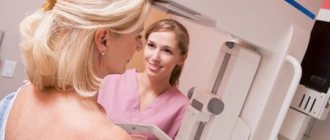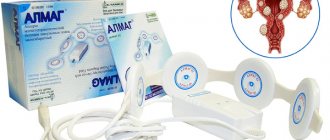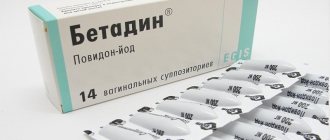| from January 11: | — delivery of oxygen concentrators in Moscow on the DAY OF ORDER! — pickup from 12-00 to 18-00 | |
Home → Physiotherapy devices → Magnetic therapy devices → Magnetotherapy → Magnetotherapy in gynecology
Magnetotherapy (16) Infrared and phototherapy (10) Vibroacoustic therapy (6) Laser therapy (4) Quantum therapy (2) Thermotherapy (3) Electrophoresis and Galvanization (5) Electrical stimulation (3)
Magnetic therapy in gynecology is used to accelerate tissue regeneration and relieve inflammation in the reproductive system in women. This physiotherapeutic method is based on the action of magnetic fields with different characteristics on the pathological focus.
Treatment with magnetotherapy in gynecology can be:
- distant (through the abdominal wall);
- abdominal (through the vagina).
Reviews of magnetic therapy in gynecology indicate a pronounced therapeutic effect in the majority of patients.
Studies of the effectiveness of magnetotherapy treatment for gynecological diseases indicate a decrease in pain from the second day of use. After a week's course, pain persists in only five percent of patients. Normalization of body temperature occurs from the fourth day of use and is completely stabilized by the 14th day. Indications for magnetic therapy in gynecology:
- postoperative period;
- cervicitis;
- colpitis;
- adhesions;
- endometritis;
- infertility.
Treatment with magnetotherapy in gynecology has shown excellent results in eliminating the consequences of surgical interventions:
- healing is faster;
- there is no inflammation of the sutures and no adhesions are formed;
- external scars become less noticeable;
- menstrual function is restored several times faster.
Contraindications to magnetic therapy in gynecology:
- menstruation period;
- individual intolerance;
- acute infectious and non-infectious diseases, including fever;
- neuropsychiatric diseases in the acute phase;
- bleeding disorders;
- presence of a pacemaker;
- oncology; and some others.
Treatment can also be carried out at home using portable devices, which are widely presented on our website.
Attention! The use of magnetic therapy for the treatment of gynecological diseases is possible only after consultation with a doctor!
The procedure for conducting a magnetic therapy session is extremely simple: positioned horizontally, you need to fix the magnetic inductors in the lower abdomen (the area of the ovaries or uterus) and turn on the device. The duration of the course, as well as the duration of one session, is calculated by the doctor.
Devices for magnetic therapy
Treatment with physics
So, first we need to briefly provide information about magnetic therapy in general. This procedure is a type of physical therapy. What is physiotherapy? I’m sure everyone has heard this word, but they don’t know the exact definition of the term and haven’t tried to find out.
Physiotherapy is a field of clinical medicine that studies the effects of various physical forces—natural and artificial—on the body. This includes:
- massage;
- physiotherapy;
- acupuncture and cupping;
- electrotherapy;
- magnetic therapy;
- laser therapy;
- sunbathing;
- hydrotherapy and others.
I think many have experienced at least one of these types of physical therapy. Some of them are often prescribed to children. I myself became acquainted with electrotherapy and magnetotherapy, therapeutic exercises and massage in childhood, when I had some problems with posture. It is also common for people to undergo physical therapy during the rehabilitation period after surgery.
Do it yourself at home
As a rule, even those people who are aware of magnetic therapy and have performed it do not always know that it can be done at home! I hasten to share information about this too - yes, treatment with magnetic fields is possible at home using ordinary magnetic balls, rosaries or cylinders.
There are massage exercises that need to be done in the area of the reproductive organs in certain sessions and courses.
I am very glad that you read my article to the end. I hope it was useful and informative for you.
How magnetic fields affect us
Few people know that magnetic therapy can be performed at home. For this purpose, special magnetic balls or cylinders are used. You must first consult a doctor. Only a doctor can choose the most optimal dosage.
As for magnetic therapy, the essence of the treatment is the influence of static or pulsed magnetic fields of low frequencies on lymph and blood - the electrically conductive substances of our body.
Let's remember school physics. Magnetic fields can be constant or variable (statistical and pulsed). Variables are also classified as low-frequency or high-frequency. All magnets have 2 poles - north and south, negative and positive, respectively. Remember the "" and "-" on batteries?
The Earth also has its own magnetic field. A person has an internal magnetic field, and it is different for each organ. When these two fields match, there is no problem. But when there is a break between them, a person begins to feel unwell, a loss of strength. Have you probably felt the negative impact of magnetic storms?
A lack of magnetic field provokes diseases. It is known that astronauts, having spent time in space where there are no magnetic fields, have a deficiency of them and take a long time to recover after returning to Earth. Each field affects the body in its own way.
The action of a negative field provokes the following processes:
- increased acidity in the body;
- rapid development and growth of bacteria;
- increased performance and mental activity;
- general energy.
A positive field gives the following effects:
- anti-inflammatory;
- anesthetic;
- hemostatic;
- stopping the development of bacteria;
- increasing alkalinity and decreasing acidity;
- destruction of fatty deposits;
- relaxation of the nervous system;
- increasing the elasticity of blood vessels.
Magnets have been used as healing minerals since ancient times. There is evidence of treatment with magnets even before our era in Greek society (see information about Magnesia in Asia Minor), in ancient China.
What methods are used
There are many methods of physiotherapy:
UHF and EHF
Physiotherapy using an electromagnetic field affects inflammatory processes and has an anti-edematous effect. Electrotherapy or ultrasound therapy is usually used.
Ultrasound
Ultrasound is used due to its beneficial effects at the cellular level. The massage causes a feeling of warmth inside, and also reduces pain, softens adhesions, affects blood circulation and improves hormonal levels.
Electrophoresis
This type affects spasms and smooth muscles, improving blood circulation and providing an analgesic effect. The following are commonly used: electrical stimulation, galvanization and medicinal electrophoresis.
Magnetotherapy
Magnets in gynecology are used to improve microcirculation in the fallopian tubes and appendages. Affects the amount of discharge during the menstrual cycle.
Magnetic therapy is performed using a sensor. The treatment course is about 15-20 days.
Electrophoresis in gynecology is used quite often
Laser therapy
Laser therapy is considered the most effective among all immunostimulating and regenerative therapies. Used in gynecology for irradiation of the vulva in women aged 45 years or more in case of atrophic vulvovaginitis. Used to combat infertility and increase the chances of conception.
The whole point is to stimulate the regenerative functions of the epithelium in the genital organ, thereby improving blood flow and reducing scabies. The symptoms of crourosis and lichen are relieved. Modern medicine offers a new procedure - extravascular laser irradiation. Irradiation occurs in the area of the main vessels, thereby providing an immunomodulatory effect to reduce inflammatory processes. Effectively fights adhesions, adnexitis, endomatritis, and oophoritis.
Other methods
Other methods are also used for the prevention and treatment of gynecological diseases. They are divided into two types:
- Natural. They include various mud treatments and water procedures. Usually carried out in sanatoriums and beauty salons.
- Manual gynecological procedures.
This video will tell you about the features of using physiotherapy for pelvic diseases:
Contraindications
Magnetotherapeutic methods are not used to treat patients with certain diseases or are used to a limited extent if the doctor believes that the benefits of such treatment are higher than the possible damage.
Contraindications to sessions of such treatment are:
- Individual intolerance to the procedure.
- Persistent increase in blood pressure, myocardial infarction, aneurysm.
- Cachexia.
- Acute infectious diseases with increased body temperature.
- Epilepsy.
- Acute mental disorders.
- Presence of a pacemaker.
- Acute nervous disorders, disorders of the central nervous system.
- Tuberculosis.
- Thrombosis in the acute stage.
- Malignant neoplasms.
- Blood pathology associated with a violation of blood clotting.
Age under 1.5 years and pregnancy are considered relative contraindications for such procedures. Although their practical application took place.
There is another limitation for the treatment of gynecological diseases. Do not administer therapy during menstrual bleeding.
Hello, dear readers! I thank you for visiting my blog and interest in my new article. Do you know that a lack of magnetic field leads to illness? Today I will talk about magnetic therapy in gynecology, how to treat infertility and maintain pregnancy using ordinary magnets.
Indications
The described method of physiotherapeutic influence has found its application in both gynecology and obstetrics. It has proven itself in the treatment of inflammatory diseases of the female genital organs. It turned out to be an indispensable assistant for some types of infertility. And he showed himself excellently during the recovery stage after various types of surgical interventions.
Main indications for the procedures:
- Colpitis.
- Endometritis.
- Cervicitis.
- Adhesive processes.
- Postoperative period (wound healing, scar resorption).
- Infertility caused by the inability of eggs to transit through the fallopian tubes.
The use of magnetic fields in obstetrics does not have a deep history and should therefore be used with caution. Nevertheless, there are positive results with this method of treatment:
- Pronounced gestosis.
- Severe toxicosis.
- Iron deficiency anemia.
- NWRP.
The effectiveness of the procedure in this case is attributed to the improvement of blood microcirculation in the placenta and pelvic organs when exposed to the patient’s abdomen.
pros
Under the influence of a magnetic field, the rate of metabolic processes in tissues changes, the permeability of cell membranes changes, and other biochemical changes occur, due to which:
- Signs of inflammation (pain, swelling, hyperemia) are reduced. And in a short time.
- The speed of healing of damaged tissue increases.
- The body's resistance to bacterial infections improves.
- The absorption of drugs improves.
On practice
How is the procedure performed? I already wrote above that magnetic therapy, depending on the degree of impact, can be general - complete, and local - selective. Local therapy is used for the pelvic organs.
Technically, the procedure goes like this: you lie down on the couch on your back, the therapist applies two magnets to the lower abdomen, usually at the location of the ovaries, and turns on the device - it is usually stationary. The procedure lasts 15-20 minutes, and you don’t feel anything.
The doctor then removes the magnets and you can leave the office. That's the whole process.










